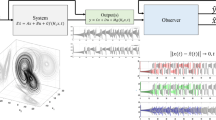Abstract
In this note, the matrix equation AV + BW = EV J is considered, where E, A and B are given matrices of appropriate dimensions, J is an arbitrarily given Jordan matrix, V and W are the matrices to be determined. Firstly, a right factorization of (sE — A)−1 B is given based on the Leverriver algorithm for descriptor systems. Then based on this factorization and a proposed parametric solution, an alternative parametric solution to this matrix equation is established in terms of the R-controllability matrix of (E, A, B), the generalized symmetric operator and the observability matrix associated with the Jordan matrix J and a free parameter matrix. The proposed results provide great convenience for many analysis and design problems. Moreover, some equivalent forms are proposed. A numerical example is employed to illustrate the effect of the proposed approach.
Similar content being viewed by others
References
G. R. Duan. Solution to matrix equation AV + BW = EV F and eigenstructure assignment for descriptor systems[J]. Automatica, 1992, 28(3): 639–643.
G. R. Duan. Solution to matrix equation AV + BW = VF and their application to eigenstructure assignment in linear systems[J]. IEEE Transactions on Automatic Control, 1993, 38(2): 276–280.
G. R. Duan. Eigenstructure assignment and response analysis in descriptor linear systems with state feedback control[J]. International Journal of Control, 69(5): 663–694.
L. R. Fletcher, J. Kautasky, N. K. Nichols. Eigenstructure assignment in descriptor systems[J]. IEEE Transactions on Automatic Control, 1986, 31(12): 1138–1141.
F. L. Lewis, K. Ozcaldiran. Geometric structure and feedback in singular systems[J]. IEEE Transactions on Automatic Control, 1989, 34(4): 450–455.
L. Dai. Singular Control Systems[M]. Berlin: Springer-Verlag, 1989.
G. R. Duan, G. P. Liu, S. Thompson. Eigenstructure assignment design for proportional-integral observers: continuous-time case[J]. IEEE Proceedings-Control Theory and Applications, 2001, 148(3): 263–267.
C. C. Tsui. A complete analytical solution to the equation TA − FT = LC and its applications[J]. IEEE Transactions on Autiomatic Control, 1987, 32(8): 742–744.
J. B. Carvalho, B.N. Datta. A new block algorithm for generalized Sylvester-observer equation and application to state estimation of vibrating systems[C]//Proceedings of the 43rd IEEE Conference on Decision and Control. Piscutaway, NJ, USA: Institute of Electrical and Electronics Engineers Inc., 2004: 3613–3618.
G. R. Duan, A. G. Wu. Design of PI observers in descriptor linear systems[C] // Proceedings of the 22nd Chinese Control Conf. Wuhan: Wuhan University of Technology Press, 2003: 99–103.
G. R. Duan, A. G. Wu. Design of PD observers in descriptor linear systems[C] // Proceedings of the 22nd Chinese Control Conf. Wuhan: Wuhan University of Technology Press, 2003; 104–108.
B. G. Mertzios. Leverrier’s algorithm for singular systems[J]. IEEE Transactions on Automatic Control, 1984, 29(7): 652–653.
B. G. Mertzios, M. A. Christodoulou, B. L. Syrmos, et al. Direct controllability and observervability time domain conditions of singular systems[J]. IEEE Transactions on Automatic Control, 1998, 33(8): 788–791.
Author information
Authors and Affiliations
Additional information
This work was supported by the Chinese Outstanding Youth Foundation (No. 69925308) and Program for Changjiang Scholars and Innovative Research Team in University.
Aiguo WU was born in Gong’an County, Hubei Province on September 20, 1980. He received his B.E. degree in Automation in 2002 and M.E. degree in Navigation, Guidance and Control in 2004 from Harbin Institute of Technology. Currently, he is pursuing his Ph.D. degree in the Center for Control Systems and Guidance Technology at Harbin Institute of Technology. His research interests include robust control and estimation, observer design and descriptor linear systems.
Guangren DUAN was born in Heilongjiang Province on April 5, 1962. He received his B.S. degree in Applied Mathematics, and both his M.S. and Ph.D. degrees in Control Systems Theory. From 1989 to 1991, he was a post-doctoral researcher at Harbin Institute of Technology, where he became a professor of control systems theory in 1991. Prof. Duan visited the University of Hull, UK, and the University of Sheffield, UK from December 1996 to October 1998, and worked at the Queen’s University of Belfast, UK from October 1998 to October 2002. Since August 2000, he has been elected Specially Employed Professor at Harbin Institute of Technology sponsored by the Cheung Kong Scholars Program of the Chinese government. He is currently the Director of the Center for Control Systems and Guidance Technology at Harbin Institute of Technology. He is the author and co-author of over 400 publications. His main research interests include robust control, eigenstructure assignment, descriptor systems, missile autopilot control and magnetic bearing control. Dr. Duan is a Charted Engineer in the UK, a Senior Member of IEEE and a Fellow of IEE.
Bin ZHOU was born in HuBei Province, China, in 1981. He received the Bachelor’s degree from the Department of Control Science and Engineering at Harbin Institute of Technology, Harbin, China, in 2004. He is now a graduate student in the Center for Control Systems and Guidance Technology in Harbin Institute of Technology. His current research interests include linear systems theory and constrained control systems.
Rights and permissions
About this article
Cite this article
Wu, A., Duan, G. & Zhou, B. An explicit solution to the matrix equation AV+BW=EV J . J. Control Theory Appl. 5, 47–52 (2007). https://doi.org/10.1007/s11768-005-5173-x
Received:
Revised:
Issue Date:
DOI: https://doi.org/10.1007/s11768-005-5173-x




